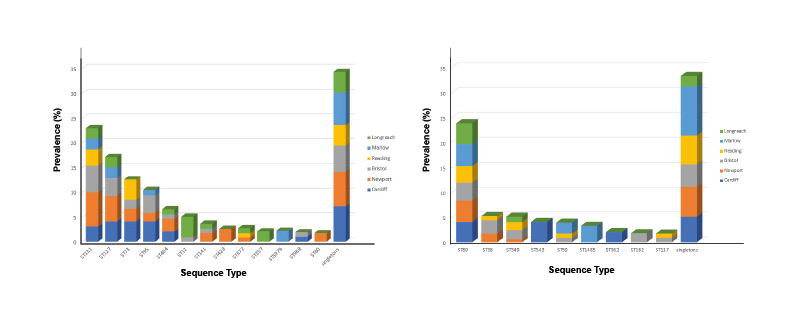BACKGROUND AND AIMS
Escherichia coli are a hugely diverse group of bacteria that include harmless commensals as well as virulent pathogens. They are the leading cause of bacterial sepsis throughout Europe, which has more than doubled in prevalence in the last two decades. Currently, they are commonly classified by multilocus sequence typing into >10,000 sequence types (ST). Of these, only a tiny minority (0.06%), spearheaded by ST131, ST73, ST127, ST95, and ST69, cause the majority (>60%) of E. coli sepsis events throughout Europe and North America. The authors hypothesised that the rising rates of E. coli sepsis are due to rising human carriage rates of these virulent E. coli types in the UK community, and designed a study to test this hypothesis by analysing the prevalence of these types in UK regions with known disparate E. coli sepsis rates.
MATERIALS AND METHODS
Due to the vast amount of mechanical mixing in UK sewers and upon entry to wastewater treatment plants, homogenised human sewage is an ideal medium to use to measure community carriage prevalence of virulent E. coli. This is due to the fact that tens of thousands of human gut samples are normalised into a single sample, representing tens of thousands of individuals. Sewage was sampled (September 2019) on entry to six wastewater treatment plants in the UK located at the East and West ends of the M4 motorway corridor, locations chosen for low and high geographic E. coli sepsis rates, respectively. Three sites (Cardiff, Newport, and Bristol) were located at the west end of the motorway corridor and three sites (Reading, Marlow, and Longreach) were at the east end.
At the same time, the authors sampled pooled sewage from nine sites in Dhaka, Bangladesh, to serve as controls because they had previously demonstrated very low carriage (0–1%) of virulent E. coli types in South Asia on several occasions.1,2 Approximately 150 E. coli were randomly isolated (without antibiotic selection on BrillianceTM UTI Agar plates; Oxoid, Basingstoke, UK) from each sample, including triplicate and duplicate isolations from Newport (September and October 2019, respectively). Species identification was confirmed for 634 initial E. coli isolates and 410 replicate isolates from the Newport site by matrix-assisted laser desorption ionisation–time of flight mass spectrometry. Phylotypes were determined by the Clermont multiplex phylotype PCR3 for all 1,044 isolates. STs were initially determined for all B2 and D isolates by Doumith ST PCR4 and either confirmed or corrected by whole genome sequencing (WGS; n=224/634). Resistance genes and virulence genes were identified by in silico analysis of the WGS.
RESULTS
The prevalence of B2 phylotype E. coli was statistically different between M4 West and East sites (27% versus 15%; p=9.2×10-5) as well as between England and Wales (17% versus 29%; p=2.5×10-4), mirroring the E. coli sepsis rates. The most prevalent STs determined by WGS mirrored the most commonly identified E. coli types causing urinary tract infections and sepsis in the UK for both phylotype B2 and D (Figure 1). The Doumith PCR method gave poor results, misidentifying many isolates. Replicate samples indicated that sampling was statistically robust both within and between samples. Virulent E. coli STs from sewage mapped among bacteraemia isolates by core genome multilocus sequence typing and resistance/virulence gene analysis, including fimH typing.

Figure 1: Chart indicating the percent prevalence of A) phylotype B2 Escherichia coli sequence types and B) phylotype D E. coli sequence types at each site in the UK. The most common sequence types corresponded to the sequence types that cause most UK sepsis events.
ST: sequence type.
CONCLUSIONS
The UK has a very high gut carriage rate of virulent extra-intestinal pathogenic E. coli, which is dramatically different to that of South Asia. The different prevalence in gut carriage between England and Wales provides a reasonable explanation of differing geographical E. coli sepsis rates and may also explain the overall rising E. coli sepsis rate for the UK over the last decade.








